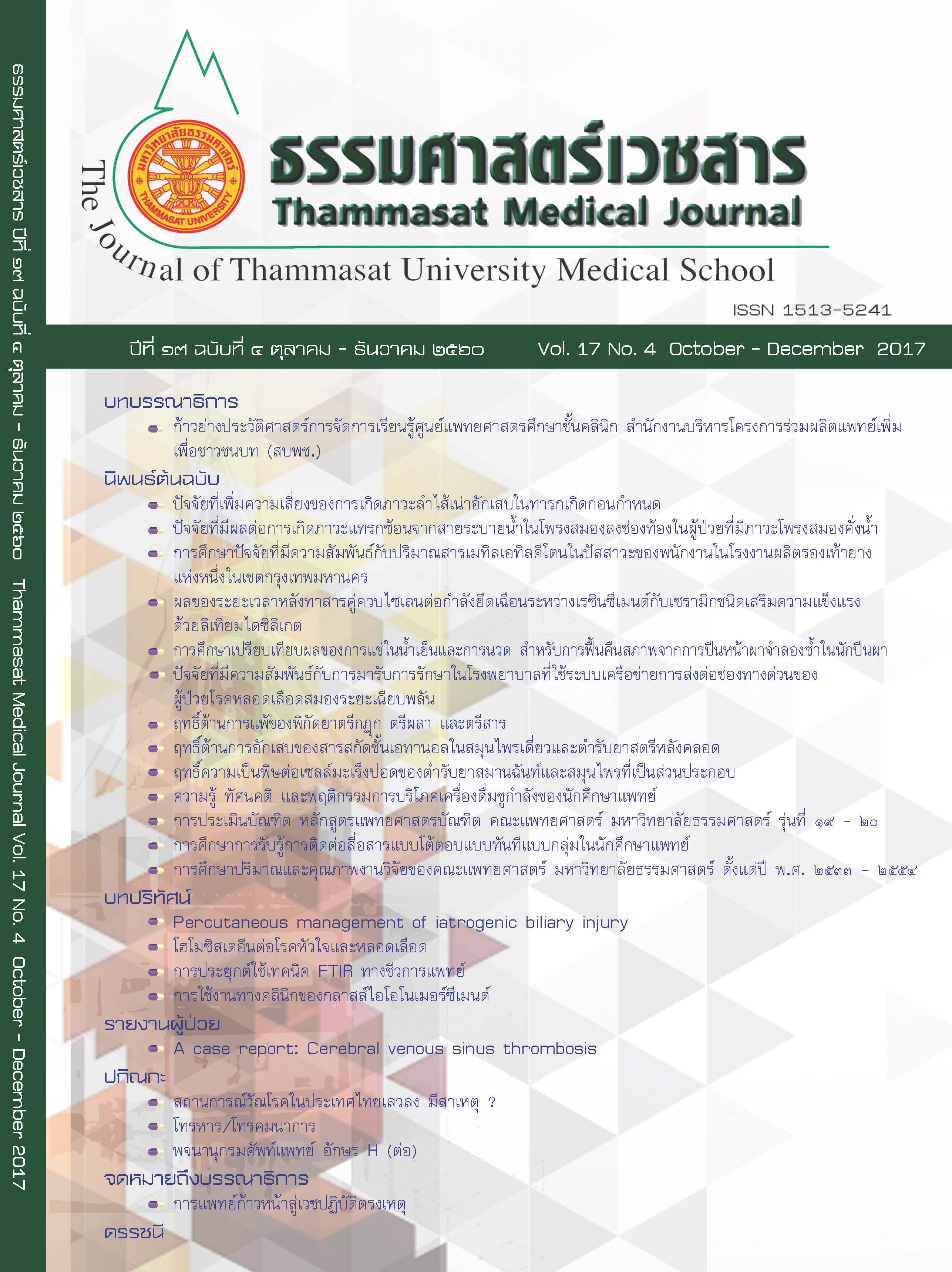A case report: Cerebral venous sinus thrombosis
Keywords:
Cerebral venous sinus thrombosis, Idiopathic intracranial hypertension, Papilledema, ภาวะหลอดเลือดดำในสมองอุดตัน, ภาวะความดันในกะโหลกศีรษะสูงโดยไม่ทราบสาเหตุ, ภาวะขั้วประสาทตาบวมอันเนื่องมาจากความดันในกะโหลกศีรษะสูงAbstract
Cerebral venous sinus thrombosis (CVST) is an uncommon neurologic condition that can present with signs and symptoms of increased intracranial pressure (ICP). The clinical presentation of CVST mimics that of idiopathic intracranial hypertension (IIH). Contrast-enhanced magnetic resonance imaging (MRI) is useful in conjunction with magnetic venography (MRV) for the detection of CVST. Early diagnosis can decrease focal neurological deficit in these patients. A 21 year-old non-obese female presented with a history of chronic headaches that have persisted for two months. The patients did not report transient visual obscuration or diplopia. Eye examination revealed bilateral swollen optic discs. Neurological examination revealed no neurological deficit. Ocular findings may be related to the effect of increased ICP. Contrast-enhanced computed tomography (CT) brain has been demonstrated normal cisterns without a mass lesion. Lumbar puncture was performed and the cerebrospinal fluid (CSF) opening pressure was elevated; the CSF composition was normal. Contrast-enhanced MRI and MRV brain have been demonstrated partial thrombosis at the anterior part of the superior sagittal sinus and the left anterior frontal/frontopolar cortical veins. The patient received a carbonic anhydrase inhibitor and anticoagulation therapy. Her symptoms resolved, and papilledema improved. We report a non-obese woman who developed chronic daily headache from CVST. CVST should be considered in the differential diagnosis of intracranial hypertension.
บทคัดย่อ
ภาวะหลอดเลือดดำในสมองอุดตันเป็นภาวะทางระบบประสาทที่พบได้ไม่บ่อยมาด้วยอาการและอาการแสดงของความดันในกะโหลกศีรษะสูงขึ้นได้ ซึ่งลักษณะทางคลินิกจะคล้ายกับภาวะความดันในกะโหลกศีรษะสูงโดยไม่ทราบสาเหตุ การตรวจเอกซเรย์คลื่นแม่เหล็กไฟฟ้าสมองและหลอดเลือดดำมีประโยชน์ในการวินิจฉัยภาวะนี้ การตรวจวินิจฉัยได้อย่างทันท่วงทีมีความสำคัญเพราะภาวะนี้อาจทำให้มีภาวะแทรกซ้อนทางระบบประสาทตามมา รายงานผู้ป่วยหญิงไทยรูปร่างสมส่วน อายุ ๒๑ ปีมาด้วยอาการปวดศีรษะเรื้อรังและปวดศีรษะรุนแรงจนต้องตื่นกลางดึกมา ๒ เดือนโดยไม่มีอาการตามัวชั่วขณะหรือเห็นภาพซ้อน ตรวจตาพบขั้วประสาทตาบวมทั้งสองข้าง การตรวจทางระบบประสาทไม่พบอัมพาตของเส้นประสาทสมองเส้นอื่น ผลการตรวจเข้าได้กับภาวะขั้วประสาทตาบวมอันเนื่องมาจากความดันในกะโหลกศีรษะสูง ผลตรวจเอกซเรย์คอมพิวเตอร์สมองไม่พบพยาธิสภาพผิดปกติในสมอง ผลตรวจน้ำหล่อเลี้ยงไขสันหลังพบความดันของน้ำหล่อเลี้ยงไขสันหลังสูงโดยไม่มีเซลล์ผิดปกติ ผลตรวจเอกซเรย์คลื่นแม่เหล็กไฟฟ้าสมองและหลอดเลือดด้วยการฉีดสีพบภาวะอุดตันบางส่วนของหลอดเลือดดำซุพีเรียร์ ซาจิตตัล ไซนัสด้านหน้าและภาวะอุดตันของหลอดเลือดดำฟรอนทัลและหลอดเลือดดำฟรอนโทโพลาร์ คอร์ติคัลด้านซ้าย ผู้ป่วยได้รับการรักษาด้วยยากลุ่มคาร์บอนิก แอนไฮเดรส อินฮิบิเตอร์และยาต้านการแข็งตัวของเลือด ภายหลังการรักษาอาการปวดศีรษะและภาวะขั้วประสาทตาบวมดีขึ้น ภาวะหลอดเลือดดำในสมองอุดตันเป็นภาวะที่ควรตระหนักถึงในผู้ป่วยที่มีอาการปวดศีรษะโดยที่มีลักษณะทางคลินิกไม่จำเพาะกับภาวะความดันในกะโหลกศีรษะสูงโดยไม่ทราบสาเหตุ



